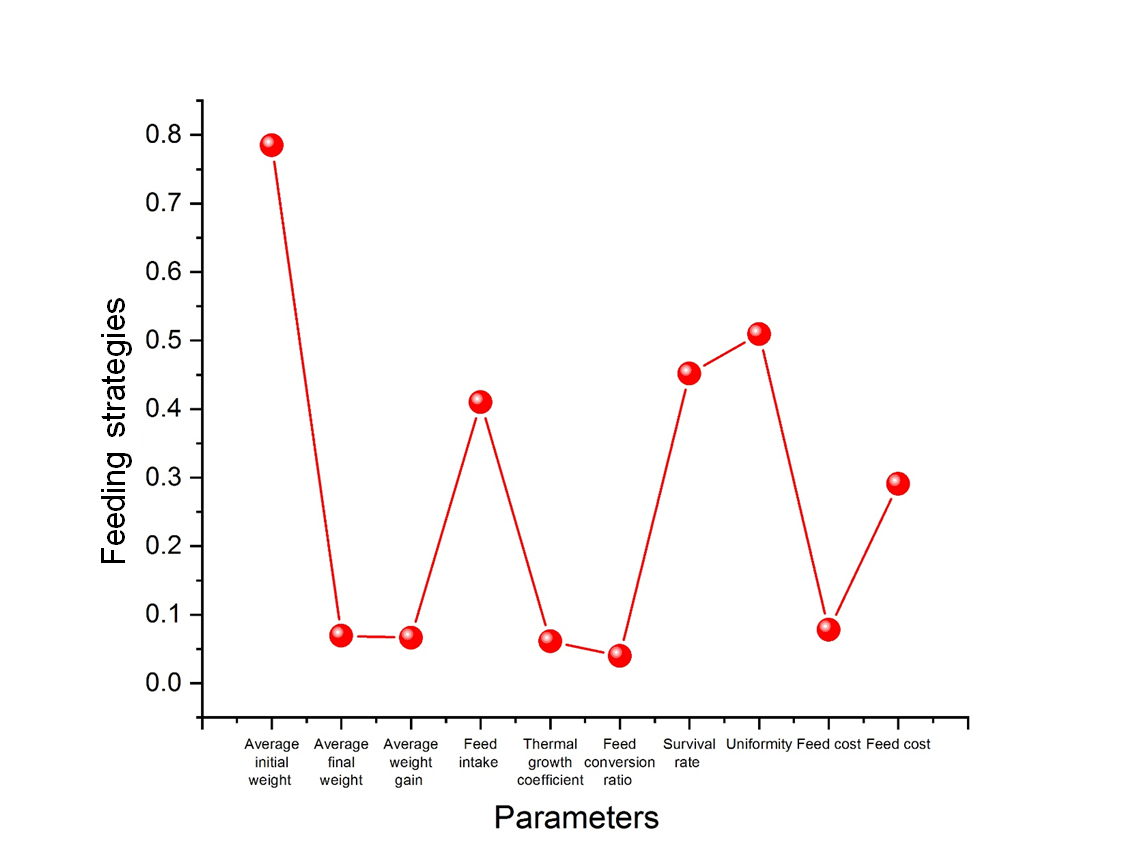Dietary Energy: Protein Ratios and Their Impact on Juvenile Nile Tilapia Growth in Mixed Feeding Approaches
Abstract
To guarantee the sustainability of aquaculture, feeding practices must be evaluated. In this research, two diets were given to young Nile tilapia with varying Energy: Protein (E: P) ratios (10.3 and 9.6 kcal of digestible energy per gram of crude protein). Economic factors, whole-body composition, hepatic steatosis, feed, growth, and nutrient consumption were assessed in the fish. The fish's uniformity, feed consumption, feed conversion ratio, growth, and survival were unaffected by the treatments. Nile tilapia juveniles fed a diet containing 10.3 kcal DE/g CP during a seven-day period saw lower feed costs (P>0.05 per biomass or 1,000 units generated). The feeding protocols increased the amount of the 10.3 kcal DE/g CP meal consumed, which reduced (P=0.055) the contribution of the ether extract to fish weight gain. The whole-body lipid levels of fish showed a similar pattern. Fish from various treatments had comparable body indices (P>0.05). Nile tilapia juveniles perform productively when given a weekly feeding program that combines meals with various E: P ratios.
References
Litaiff, I., Moesch, S., Sado, R.Y. and Bicudo, Á.J.D.A., 2023. Effects of mixed feeding strategies with different dietary energy: protein ratios on juvenile Nile tilapia (Oreochromis niloticus). Ciência Animal Brasileira, 24, pp.e-74420E.
Rodjaroen, S., Thongprajukaew, K., Jaihao, P., Saekhow, S. and Nuntapong, N., 2020. Mixed feeding schedules switching between dietary crude protein levels for mono-sex male Nile tilapia (Oreochromis niloticus). Aquaculture reports, 18, p.100509.
Konnert, G.D., Gerrits, W.J., Gussekloo, S.W. and Schrama, J.W., 2022. Balancing protein and energy in Nile tilapia feeds A meta‐analysis. Reviews in Aquaculture, 14(4), pp.1757-1778.
Konnert, G.D.P., Martin, E., Gerrits, W.J.J., Gussekloo, S.W.S., Masagounder, K., Mas-Muñoz, J. and Schrama, J.W., 2022. Interactive effects of protein and energy intake on nutrient partitioning and growth in Nile tilapia. Animal, 16(4), p.100494.
Magbanua, T.O. and Ragaza, J.A., 2022. Selected dietary plant-based proteins for growth and health response of Nile tilapia Oreochromis niloticus. Aquaculture and Fisheries.
Abdel-Aziz, M.F.A., Hassan, H.U., Yones, A.M., Abdel-Tawwab, Y.A. and Metwalli, A.A.A.T., 2021. Assessing the effect of different feeding frequencies combined with stocking density, initial weight, and dietary protein ratio on the growth performance of tilapia, catfish, and carp. Scientific African, 12, p.e00806.
Klahan, R., Yuangsoi, B., Whangchai, N., Ramaraj, R., Unpaprom, Y., Khoo, K.S., Deepanraj, B. and Pimpimol, T., 2023. Biorefining and biotechnology prospects of low-cost fish feed on Red tilapia production with different feeding regimes. Chemosphere, 311, p.137098.
Suehs, B.A. and Gatlin, D.M., 2022. Evaluation of a Commercial High-Protein Distiller’s Dried Grain with Solubles (HP-DDGS) Product in the Diet of Juvenile Nile Tilapia (Oreochromis niloticus). Aquaculture Nutrition, 2022.
Azaza, M.S., Saidi, S.A., Dhraief, M.N. and El-Feki, A., 2020. Growth performance, nutrient digestibility, hematological parameters, and hepatic oxidative stress response in juvenile Nile tilapia, Oreochromis niloticus, fed carbohydrates of different complexities. Animals, 10(10), p.1913.
Klahan, R., Krajabthong, K., Maksiri, W., Tamruangit, J., Whangchai, N., Pimpimol, T. and Whangchai, K., 2023. The influence of Napier grass biomass mixed feed on the biorefinery indicator for Nile tilapia production. Biomass Conversion and Biorefinery, pp.1-10.
Dawood, M.A., Amer, A.A., Gouda, A.H. and Gewaily, M.S., 2023. Interactive effects of cyclical fasting, refeeding, and dietary protein regimes on the growth performance, blood health, and intestinal histology of Nile tilapia (Oreochromis niloticus). Aquaculture, 573, p.739620.
Mohammady, E.Y., Aboseif, A.M., Soaudy, M.R., Ramadan, E.A. and Hassaan, M.S., 2023. Appraisal of fermented wheat bran by Saccharomyces cerevisiae on growth, feed utilization, blood indices, intestinal and liver histology of Nile tilapia, Oreochromis niloticus. Aquaculture, p.739755.
Ashraf, Y., Shalaby, S.M., Elsheikh, E.A., El-Desoki, A.A., El Basuini, M.F., Ahmed-Farid, O.A.H. and Abdel-Aziz, M.F., 2023. Assessing Chamomile and Marjoram Meals as Feed Additives on Growth Indices and Haematological Parameters of Nile Tilapia (Oreochromis niloticus) Reared Under Biofloc System. Scientific African, p.e01755.
Soltan, N.M., Soaudy, M.R., Abdella, M.M. and Hassaan, M.S., 2023. Partial dietary fishmeal replacement with a mixture of plant protein sources supplemented with exogenous enzymes modifies growth performance, digestibility, intestinal morphology, and haemato-biochemical and immune responses for Nile tilapia, Oreochromis niloticus. Animal Feed Science and Technology, 299, p.115642.
Furuya, W.M., Brandes, A., Michelato, M., Cruz, T.P.D. and Furuya, V.R.B., 2023. Commercial enzyme complex (Allzyme®) improves feed digestibility for pre-grow-out Nile tilapia. Ciência e Agrotecnologia, 47, p.e000923.
El-Ouny, Y.M., Maulu, S., Zaki, M.A., Helaly, A.A., Nour, A.A.M., ElBasuini, M.F., Labib, E.M., Khalil, R.H., Gouda, A.H., Hessein, A.A. and Verdegem, M., 2023. Effect of fishmeal replacement with dried red wigglers (Eisenia fetida) worm meal on growth and feed utilization, production efficiency, and serum biochemistry in Nile tilapia (Oreochromis niloticus) fingerlings. Aquaculture Reports, 29, p.101518.
Abdelhamid, A.F., Gewida, A.G., El-Sayed, A.F.M. and Badran, M.F., 2023. Impacts of different levels of vitamin K on the growth performance, hematological parameters, and immunological response of juvenile Nile tilapia (Oreochromis niloticus). Aquaculture International, pp.1-12.
Dawit Moges, F., Hamdi, H., Al-Barty, A., Zaid, A.A., Sundaray, M., Parashar, S.K.S., Gubale, A.G. and Das, B., 2022. Effects of selenium nanoparticle on the growth performance and nutritional quality in Nile Tilapia, Oreochromis niloticus. PloS one, 17(6), p.e0268348.
Burns, A. and Gatlin III, D.M., 2022. Effects of sustained swimming exercise on growth and body composition responses of Nile tilapia (Oreochromis niloticus), red drum (Sciaenops ocellatus), and hybrid striped bass (Morone chrysops× M. saxatilis). Fish Physiology and Biochemistry, 48(5), pp.1401-1411.
Srisakultiew, N., Kumkhong, S., Marandel, L., Plagnes-Juan, E., Panserat, S. and Boonanuntanasarn, S., 2022. The short initial period of high carbohydrate feeding improves nutrient utilization in juvenile Nile tilapia (Oreochromis niloticus) fed a high carbohydrate diet. Aquaculture, 561, p.738661.







